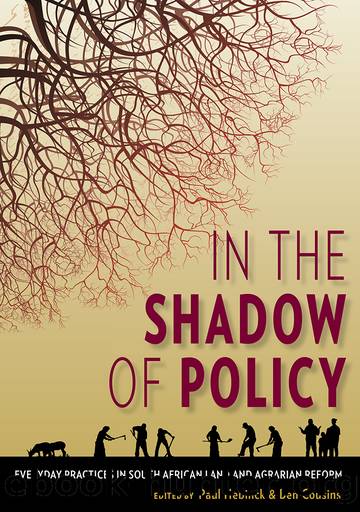In the Shadow of Policy by unknow

Author:unknow
Language: eng
Format: epub
Tags: Nonfiction, Social & Cultural Studies, Social Science
ISBN: 9781776142941
Publisher: Wits University Press
Published: 2013-10-01T04:00:00+00:00
11
Land compensation in
the upper Kat River valley
Robert Ross
Land compensation is by definition about history. The whole process is concerned with redressing the injustices caused by the racist nature of South African society and the racist measures of the South African state between 1913, a couple of years after the foundation of the Union, and 1994, the end of the apartheid era. Claims to land, and thus to compensation, have to be made on the basis of historical events, and indeed the standards of proof required to make a successful claim have been those of historical enquiry, not those of a court of law. In this way, as in others, the new South Africa attempts to redress the inequities of the old.
The problem with such laudable proposals is that history has sometimes developed in too complicated a way for the simple assumptions of the Land Claims Commission to be fulfilled. In this chapter I discuss one such case, that of the upper Kat River valley in the Eastern Cape. This has become one of the last areas of the country in which land claims have still to be settled. The cynic would suggest that part of the reason for this is that many, though by no means all, of the claimants are either whites or people of Khoisan descent. More generally, though, it has to be realised that the history of the valley, in particular the history of land ownership and allocation, has been extraordinarily complex.
The region in question lies in the upper catchment area of the Kat River valley in the Eastern Cape, to the north of Fort Beaufort. Essentially, the valley is a basin cut into the outliers of the Amathole mountains by a number of small streams which come together to form the Kat and the Blinkwater rivers. Just below the confluence of these two streams, the combined river runs through a narrow gorge, known as the Poort, before passing Fort Beaufort on its way to join the Great Fish River, and thence to the sea. In the upper Kat valley, the streams have eroded away a number of relatively broad areas of fertile bottomland, which is surrounded by rough grazing and, higher up, a corona of mist forest.
The area straddles the great ecological divide of southern Africa: the region where agriculture on the basis of summer rains was possible and the region where it could not be practised with the crops that were available in pre-colonial times. The valleys, which run north into the hills of the Amathole and the Tyhume Valley to the east of the Kat, were historically areas of Xhosa settlement. In fact the area formed the heartland of the Ngqika chieftainship during the early nineteenth century. In contrast, the Koenap Valley to the west of the Kat never had a significant number of Xhosa inhabitants. In the nineteenth century it became a centre of sheep farming and one of the richest areas that were controlled by white settlers (Ross 1993: 59).
The Kat basin itself would seem to have enough rain at the right time of the year to grow summer rainfall crops.
Download
This site does not store any files on its server. We only index and link to content provided by other sites. Please contact the content providers to delete copyright contents if any and email us, we'll remove relevant links or contents immediately.
International Integration of the Brazilian Economy by Elias C. Grivoyannis(91574)
The Radium Girls by Kate Moore(11929)
Turbulence by E. J. Noyes(7942)
Nudge - Improving Decisions about Health, Wealth, and Happiness by Thaler Sunstein(7622)
The Black Swan by Nassim Nicholas Taleb(7016)
Rich Dad Poor Dad by Robert T. Kiyosaki(6413)
Pioneering Portfolio Management by David F. Swensen(6229)
Man-made Catastrophes and Risk Information Concealment by Dmitry Chernov & Didier Sornette(5924)
Zero to One by Peter Thiel(5691)
Secrecy World by Jake Bernstein(4652)
Millionaire: The Philanderer, Gambler, and Duelist Who Invented Modern Finance by Janet Gleeson(4383)
The Age of Surveillance Capitalism by Shoshana Zuboff(4214)
Skin in the Game by Nassim Nicholas Taleb(4165)
Bullshit Jobs by David Graeber(4100)
The Money Culture by Michael Lewis(4082)
Skin in the Game: Hidden Asymmetries in Daily Life by Nassim Nicholas Taleb(3935)
The Dhandho Investor by Mohnish Pabrai(3705)
The Wisdom of Finance by Mihir Desai(3658)
Blockchain Basics by Daniel Drescher(3511)
